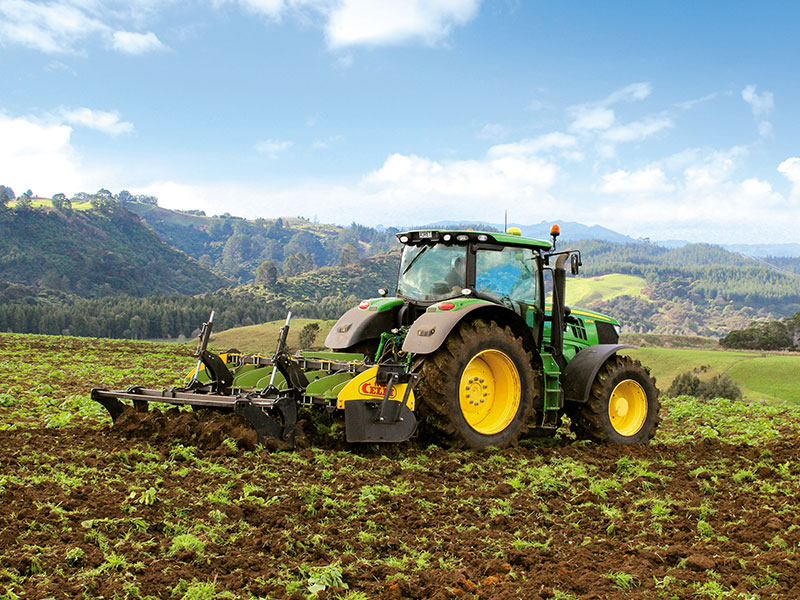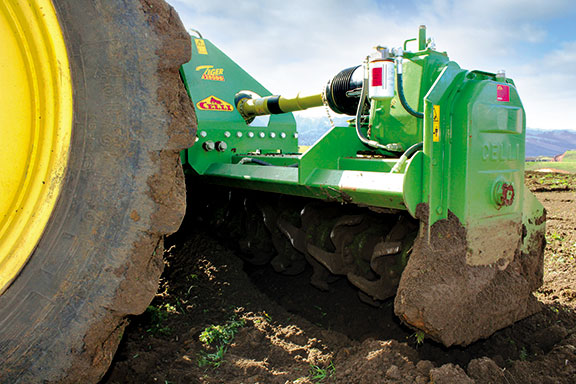Brent Lilley checks out a Celli ALCE-P deep ripper and a Celli Tiger 280 DD rotary hoe, the perfect combination
Getting tasks done efficiently is crucial in most farming operations. It becomes even more important with high-value vegetable production to maximise yields of limited amounts of fertile soil in the right locations.
Hinemoa Quality Producers is a family operation farming more than 200ha of land in Pukekawa, near Auckland on New Zealand’s North Island.
The property mainly revolves around 150ha of land planted in double crops of potatoes, onions and barley. The Hinemoa team plants almost all year round to achieve continual supply of produce to the market.
There is a strong focus on looking after soils while improving yields, so when preparing for planting, getting the land cultivated in a timely manner is hugely important. When preparing the ground for potatoes, the soil is first deep ripped to remove any compaction and a rotary hoe is then used to achieve a fine seedbed to a depth that can be ridged into beds.
Hinemoa recently bought two new Celli machines – a Celli ALCE-P deep ripper and a Celli Tiger 280 DD rotary hoe — so I caught up with one of the company’s leading operators, Brett Parker, to see just how well these machines work together in the field.
 |
|
The Celli ALCE-P deep ripper and Tiger 280 DD rotary hoe behind a John Deere 6210R tractor
|
Celli ALCE-P deep ripper
When you look at this machine, its heavy-duty construction is immediately apparent. A robust box section frame carries the ripping legs and the rear roller, while a strong linkage on the front uses CAT 3 pins to hitch up to the tractor.
A modular system, where the legs are bolted to the frame, means that the number of legs or spacings can easily be adjusted to future-proof the machine.
The overall weight sits at a little more than two tonnes, which helps keep it in the ground when working. As a large amount of this weight is at the rear of the machine in the roller, you definitely require a decent-sized tractor with some serious ballast on the front to lift the machine out of the ground.
Across the 3.5m width of the machine are seven legs. These are staggered in two rows to prevent blockages and can rip down to around 600mm in the ground. The curved design is said to lower horsepower requirements, although I would suggest the 210hp John Deere 6210R we used in the test is probably the absolute bare minimum, with the ripper usually being run on an 8235R.
Another benefit to the curved design is that it lifts different areas of the soil profile at different times. This helps minimise bringing the lower subsoil to the surface.
A 50mm-wide replaceable square chisel point is used on the end of each leg, and as an option that was fitted, there are three soil blades that can be bolted to the machine.
Two horizontal wings on either side of the main leg have a lifting effect, which ensures all soil between the legs is loosened.
A third vertical blade on the front of the leg slices through the soil before the leg. This also helps break up the soil profile and minimise the amount of subsoil clods brought to the surface.
The legs are held in place with two bolts. One large retaining bolt from side to side and a 16mm shear bolt from front to back. If an object is struck, the 16mm bolt will shear and the leg will pivot back and up away from the obstacle to prevent damage to the machine.
On the outside are side deflector plates. These are great to see, as they keep the soil inside the width of the machine. These plates can be folded up for transport to keep the machine to a 3.5m width.
At the rear are two spike-toothed rollers to help break up clods and lightly cultivate the surface. The clever design and close proximity to each other means that the teeth on each roller help clean the other roller as they turn.
Being in the middle of quite a wet winter over here, I would describe the conditions as sticky and testing for any machine. The rollers didn’t clog or stop turning, which I think is quite impressive.
This roller on the rear can be hydraulically adjusted from the cab, which in turn changes the working depth of the legs, making it easy to alter on the move. It would be a great improvement if there were a scale on these depth adjustment rams that could be seen from the cab, so the operator could easily return to a previously set height.
 |
|
The Celli Tiger can work to a depth of about 300mm
|
Celli Tiger 280 DD rotary hoe
The second machine is a Celli Tiger 280 DD 4m-wide fixed-width rotary hoe. This is quite an interesting piece of kit, and while it won’t suit everyone, it has some merits in its simplicity, without the pivot points and hydraulic rams or the price tag that come with a folding machine.
Even still, the machine weighs in at more than two tonnes. This weight helps keep the machine in the ground, and the fact that it is spread evenly across the machine, with the three gearboxes spaced evenly, also helps keep it level when working.
While this model is normally fitted with a central gearbox rated to 280hp, which is more than adequate for most uses, this particular machine took the option of a 360hp central gearbox, which ensures a good safety margin and future-proofs it.
The positioning of the central gearbox ensures that the driveshafts to the outer gearboxes are running straight. This is designed to limit wear, but when the blades were lifted clear of the ground it does create a sharp angle on the main driveshaft between the machine and the John Deere 8235R that is usually on the front. This probably wouldn’t be as much of a problem on other tractors.
Two secondary gearboxes are found on either side of the machine. Rated to 280hp, this is more than adequate once the power has been split. There is also a cam clutch found on either side to prevent damage.
The fact the drive is transferred to the rotors on the outside means only an extremely thin strip in the middle between beds is missed and a single straight tine in the centre takes care of this with ease.
Synthetic oil is used throughout the machine and each of the three gearboxes is self-contained with its own filter and pump as well as a sight glass for daily checks.
Cleverly, the oil from each gearbox is also pumped through an area of the box section frame of the machine. This acts as a heat exchanger with the air temperature to keep the oil cool as well as doubling as a reservoir. I’m told this setup works well with little trouble keeping the oil cool and no problems with radiators blocking up with dust.
Underneath the machine, the rotors use L-shaped blades that are bolted onto flanges on the cross shafts. With 90 blades across the 4m width, these can work down to a depth of around 300mm to give a fine bed of tilth, which is quite impressive.
Importantly, there is plenty of clearance around the rotor to ensure the machine can handle a variety of conditions without blocking. The hood at the rear is adjustable on a threaded bar and includes a tension spring that allows any large objects to pass through.
This hood does an excellent job keeping soil in the machine until all clods are broken down.
The Verdict
Both the Celli ALCE-P ripper and the Tiger rotary hoe are a great fit for Hinemoa Produce. The combination of these two machines has cut down the number of passes in the field and increased output. Most importantly, though, the business has had a trouble-free run from both machines so far with no downtime.
The ALCE-P ripper does an exceptional job loosening the soil and removing compaction. The spike-toothed roller on the back offers further cultivation without too much consolidation, which is ideal in this situation.
The Tiger 280 DD rotary hoe is built to handle some serious horsepower, which is exactly what Hinemoa was looking for after having problems with the gearboxes on its last rotary hoe.
While both machines work exceptionally well on their own, when used together in this situation, they are almost the perfect combination.
Celli ALCE-P deep ripper
HITS
Hydraulic depth adjustment
Rear roller design helps to smash up clods
The design of the leg helps loosen the soil profile
Shear bolts to prevent damage if an obstacle is struck
MISSES
A depth gauge on the rams to adjust the depth of the machine would be helpful for setup
Celli Tiger 280 DD rotary hoe
HITS
Main gearbox rated to 360hp
Oil for each gearbox is kept separate with its own filter
Oil is cooled inside the frame of the machine
Adjustable rear hood to suit conditions
MISSES
Sharp angle on the PTO shaft when the machine is lifted clear of the ground
Four-metre fixed width won’t suit many people but folding models are available
Photography: Brent Lilley







